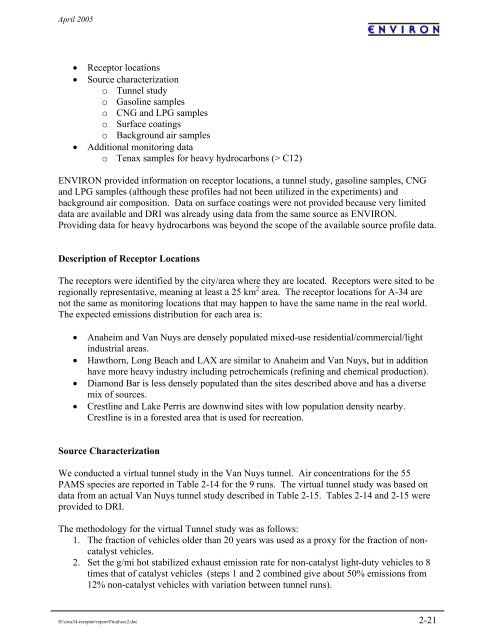CRC Report No. A-34 - Coordinating Research Council
CRC Report No. A-34 - Coordinating Research Council
CRC Report No. A-34 - Coordinating Research Council
Create successful ePaper yourself
Turn your PDF publications into a flip-book with our unique Google optimized e-Paper software.
April 2005<br />
• Receptor locations<br />
• Source characterization<br />
o Tunnel study<br />
o Gasoline samples<br />
o CNG and LPG samples<br />
o Surface coatings<br />
o Background air samples<br />
• Additional monitoring data<br />
o Tenax samples for heavy hydrocarbons (> C12)<br />
ENVIRON provided information on receptor locations, a tunnel study, gasoline samples, CNG<br />
and LPG samples (although these profiles had not been utilized in the experiments) and<br />
background air composition. Data on surface coatings were not provided because very limited<br />
data are available and DRI was already using data from the same source as ENVIRON.<br />
Providing data for heavy hydrocarbons was beyond the scope of the available source profile data.<br />
Description of Receptor Locations<br />
The receptors were identified by the city/area where they are located. Receptors were sited to be<br />
regionally representative, meaning at least a 25 km 2 area. The receptor locations for A-<strong>34</strong> are<br />
not the same as monitoring locations that may happen to have the same name in the real world.<br />
The expected emissions distribution for each area is:<br />
• Anaheim and Van Nuys are densely populated mixed-use residential/commercial/light<br />
industrial areas.<br />
• Hawthorn, Long Beach and LAX are similar to Anaheim and Van Nuys, but in addition<br />
have more heavy industry including petrochemicals (refining and chemical production).<br />
• Diamond Bar is less densely populated than the sites described above and has a diverse<br />
mix of sources.<br />
• Crestline and Lake Perris are downwind sites with low population density nearby.<br />
Crestline is in a forested area that is used for recreation.<br />
Source Characterization<br />
We conducted a virtual tunnel study in the Van Nuys tunnel. Air concentrations for the 55<br />
PAMS species are reported in Table 2-14 for the 9 runs. The virtual tunnel study was based on<br />
data from an actual Van Nuys tunnel study described in Table 2-15. Tables 2-14 and 2-15 were<br />
provided to DRI.<br />
The methodology for the virtual Tunnel study was as follows:<br />
1. The fraction of vehicles older than 20 years was used as a proxy for the fraction of noncatalyst<br />
vehicles.<br />
2. Set the g/mi hot stabilized exhaust emission rate for non-catalyst light-duty vehicles to 8<br />
times that of catalyst vehicles (steps 1 and 2 combined give about 50% emissions from<br />
12% non-catalyst vehicles with variation between tunnel runs).<br />
H:\crca<strong>34</strong>-receptor\report\Final\sec2.doc 2-21
















